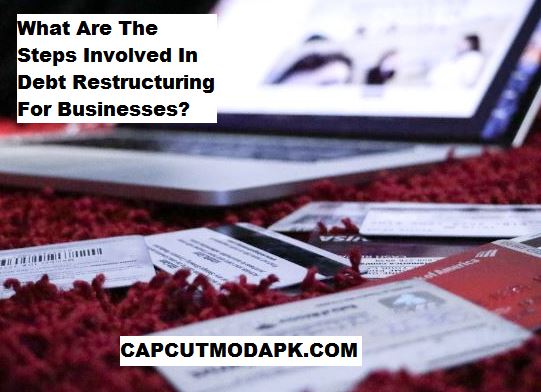What Are The Steps Involved In Debt Restructuring For Businesses: Debt restructuring is a critical option for businesses that are facing financial difficulties and are struggling to meet their debt obligations. Rather than choosing bankruptcy, businesses may seek a way to reduce, modify, or extend their existing debt to regain stability and avoid insolvency. Debt restructuring allows businesses to make adjustments to their debts, including negotiating new terms with creditors, to improve their financial situation. It is often considered a strategic way to recover from financial hardship.
The process of debt restructuring for businesses is complex and requires careful planning and negotiation. The goal is to create a feasible path that enables a business to stay operational while working through its financial challenges. However, each business situation is different, and there are various factors to consider when deciding whether debt restructuring is the right option. Understanding the steps involved in this process is essential for any business owner who may be facing significant financial difficulties.
In this article, we will explore the steps involved in debt restructuring for businesses. From understanding the restructuring process to knowing how to approach creditors and implement a new plan, we will guide you through the key aspects of business debt restructuring and the options available to help your business recover.
Also, READ
What Assets Can I Keep If I File For Bankruptcy?
How Long Does A Bankruptcy Stay On My Credit Report
What Is the Process of Debt Restructuring?
The process of debt restructuring typically begins when a business realizes that it is unable to meet its debt obligations as scheduled. This can happen due to a variety of reasons, such as declining sales, economic downturns, or poor financial management. When a company enters debt restructuring, the goal is to find a way to ease the burden of the debt without resorting to bankruptcy.
The first step in the process is to assess the company’s financial situation. This includes reviewing financial statements, understanding cash flow, and identifying how much debt is owed and to whom. A business needs to determine whether it can continue to make debt payments and if restructuring is a viable option.
Once the financial assessment is completed, the company will need to develop a restructuring plan. This plan typically involves negotiations with creditors, where the business seeks new terms to make debt repayment more manageable. These new terms can include extending the repayment period, reducing interest rates, or even negotiating for a reduction in the total amount owed.
After the restructuring plan is developed, the business must implement it. This includes formalizing the new agreements with creditors, adjusting internal operations, and ensuring that all stakeholders are aligned with the new terms. Debt restructuring is an ongoing process, and businesses must continue to monitor their financial health to ensure the new terms are being met.
What Are the Four Steps of Restructuring?
Debt restructuring for businesses involves a series of steps that need to be carefully followed. The following four steps outline the general process:
1. Assessment of Financial Health
The first and most important step in the restructuring process is a thorough assessment of the business’s financial condition. This involves reviewing financial documents, such as income statements, balance sheets, and cash flow reports, to understand the extent of the company’s debt and overall financial health. The goal is to determine how much debt the business owes and which debts are the most pressing.
During this phase, it’s also important to identify the root causes of the financial distress, such as poor management decisions, external factors, or economic challenges. By understanding the full picture, the business can develop a clear strategy to move forward.
2. Negotiating With Creditors
After assessing the financial situation, the next step is to begin negotiations with creditors. The business will need to approach its creditors and explain its financial difficulties. This is a critical part of the restructuring process, as creditors may be reluctant to modify the terms of existing debts. However, creditors typically prefer a restructuring agreement to bankruptcy because it allows them to recover more of the outstanding debt.
During negotiations, the business may seek to extend the repayment period, lower interest rates, or even request a reduction in the total amount owed. Successful negotiations are key to the success of the restructuring plan, as creditors need to agree to the new terms for the plan to move forward.
3. Developing the Restructuring Plan
Once agreements are reached with creditors, the next step is to develop a formal restructuring plan. This plan outlines the new terms of the debt, including revised payment schedules, interest rates, and any other agreed-upon changes. The plan may also include changes to the business’s operations, such as cost-cutting measures or strategic shifts to improve profitability.
The restructuring plan should be designed to create a sustainable financial path for the business. It is essential that the business’s cash flow is sufficient to meet the new debt obligations. The plan should also include clear goals and timelines to ensure that the business remains on track.
4. Implementation and Monitoring
The final step in the debt restructuring process is to implement the new terms and continuously monitor the business’s financial performance. This includes ensuring that the new debt payments are being made on time and in full. It may also involve making adjustments to internal operations to ensure that the business is generating enough revenue to meet its obligations.
Monitoring the progress of the restructuring plan is crucial for long-term success. If the business is unable to meet the new terms, it may need to renegotiate with creditors or take additional steps to address its financial challenges.
How to Restructure Business Debt?
Restructuring business debt involves a strategic approach that can help businesses avoid bankruptcy while addressing their financial difficulties. Here are the steps that business owners can follow to restructure their debt:
1. Identify Financial Problems
The first step in restructuring business debt is to identify the causes of the financial issues. Whether it’s poor cash flow management, a decline in sales, or external factors, understanding the root cause of the problem is essential. By identifying the problem, the business can focus on the areas that need the most attention.
2. Consult with Experts
Debt restructuring is a complex process, and business owners should seek professional advice before making any decisions. Financial advisors, accountants, and legal professionals can help assess the situation and offer guidance on the best approach. They can also help with negotiations with creditors and ensure that the restructuring plan is legally sound.
3. Negotiate with Creditors
Once the financial situation is clear, the next step is to negotiate with creditors. This can be done by explaining the business’s financial position and requesting new terms. It’s important to approach creditors with a clear and realistic plan that outlines how the new terms will help the business recover.
4. Implement the Plan
Once the creditors agree to the new terms, the business can implement the restructuring plan. This includes formalizing the agreements and adjusting internal operations to improve cash flow and profitability. Business owners should continuously monitor the implementation of the plan and make necessary adjustments as needed.
What Is the Business Restructuring Process?
Business restructuring is the process of reorganizing a company’s operations and financial structure to improve its financial health. This can involve changes to both the company’s debt and its internal operations. The business restructuring process typically follows these steps:
1. Assess the Financial Situation
The first step in business restructuring is to assess the company’s financial condition. This involves reviewing financial documents, understanding the company’s debt obligations, and identifying the causes of the financial distress.
2. Create a Restructuring Plan
Once the financial situation is understood, the next step is to create a restructuring plan. This plan should address both the company’s debt and its internal operations. The plan may involve negotiating with creditors for better terms and implementing cost-saving measures within the company.
3. Implement and Monitor the Plan
Once the restructuring plan is in place, the company must implement it. This may include renegotiating debts, restructuring the business’s operations, and making necessary internal changes. The company should continuously monitor the success of the restructuring plan and adjust it as needed.
What Are the Three Types of Debt Restructuring?

There are three main types of debt restructuring that businesses may consider:
1. Operational Restructuring
Operational restructuring focuses on changes to the company’s operations. This can include reducing costs, cutting non-essential expenses, or reorganizing departments. Operational restructuring is often the first step businesses take when facing financial difficulties.
2. Financial Restructuring
Financial restructuring involves negotiating new terms for the company’s debt. This can include extending repayment periods, reducing interest rates, or negotiating a reduction in the total amount owed. Financial restructuring helps businesses reduce their financial burden.
3. Legal Restructuring
Legal restructuring involves changing the legal structure of the company. This may include filing for bankruptcy protection, creating a new corporate entity, or negotiating with creditors through legal channels. Legal restructuring is often a last resort when other forms of restructuring are not feasible.
What Is the Small Business Restructuring Process?
For small businesses, the debt restructuring process is often simpler but still requires careful planning. Small businesses typically have fewer resources and may need to work more closely with creditors. The process includes:
- Assess the Financial Situation
- Negotiate with Creditors
- Create a Restructuring Plan
- Implement the Plan
- Monitor Progress
Small businesses may also consider debt consolidation or other government programs to help with financial recovery.
Conclusion
Debt restructuring is an important option for businesses facing financial challenges. By following the key steps in the process, businesses can negotiate better terms with creditors, adjust their internal operations, and work towards recovery. Whether you’re dealing with large corporate debt or a small business financial crisis, understanding the steps involved in debt restructuring is crucial for long term success. With the right planning and strategy, businesses can overcome financial obstacles and regain stability.


